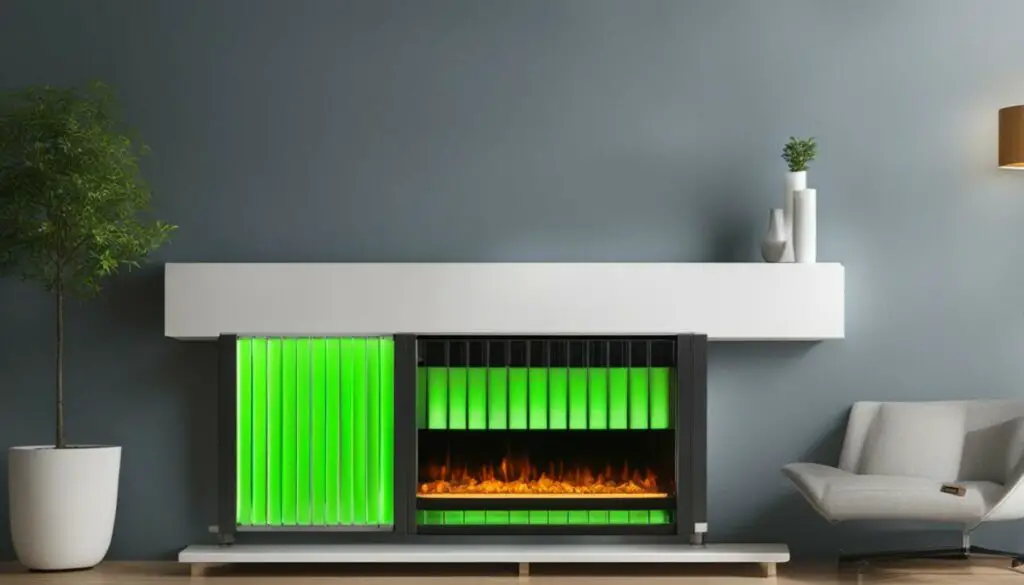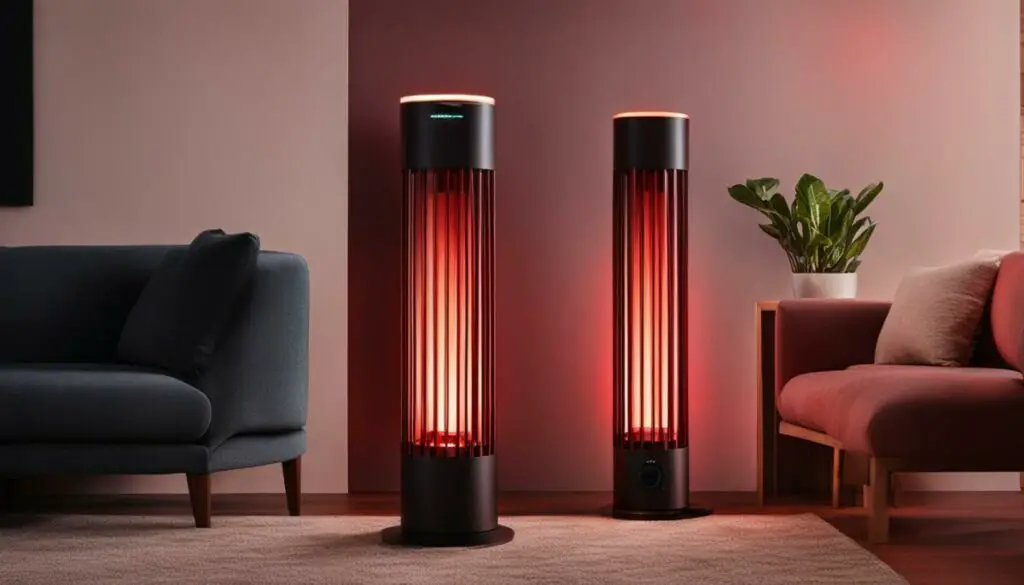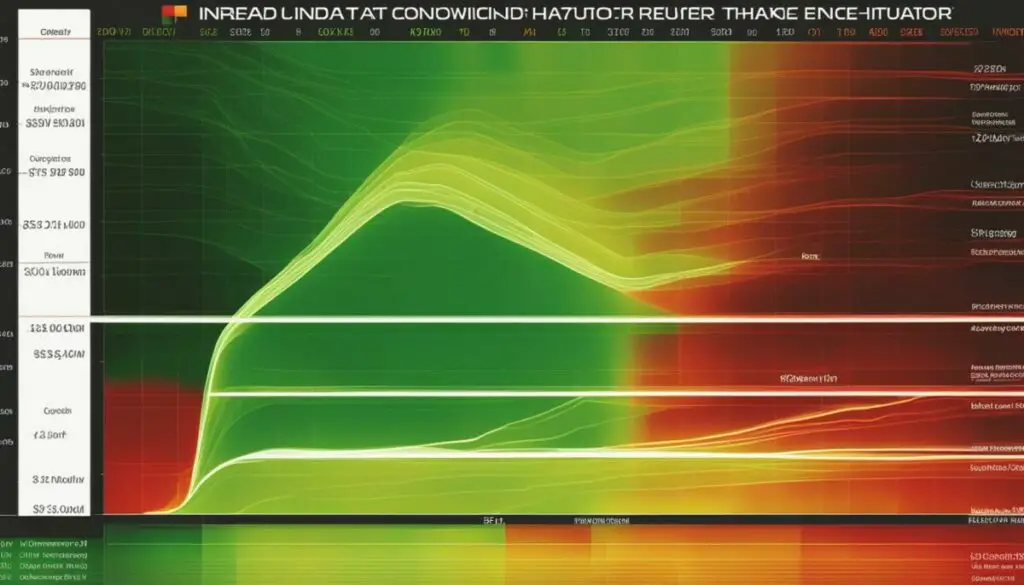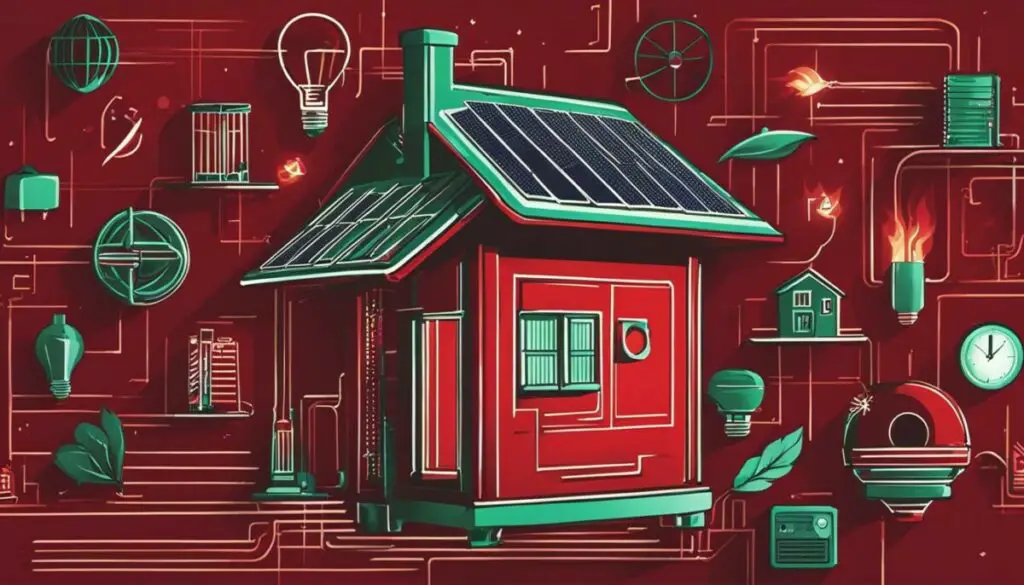Last Updated on 5 months by Francis
As temperatures drop, many homeowners are turning to infrared heaters to provide warmth and comfort in their homes. However, the question remains: are infrared heaters expensive to run? Understanding the cost of running these heaters can help you make an informed decision about whether they are the right heating solution for your needs.
While the initial cost of purchasing an infrared heater may be higher than other heating options, such as traditional electric heaters, their energy efficiency can result in long-term savings on your electric bill. But what factors contribute to the operating costs of infrared heaters?
In the following sections, we will explore the energy consumption of infrared heaters, their operating costs, and their economic efficiency. We will also provide tips for maximizing their energy efficiency and compare them to other heating options on the market. By the end of this article, you will have a clearer understanding of the cost of running infrared heaters and their potential savings.
Contents
Key Takeaways
- Infrared heaters may have a higher initial cost than other heating options, but their energy efficiency can result in long-term savings on your electric bill.
- The energy consumption and operating costs of infrared heaters depend on factors such as the size of the area being heated, the heater’s wattage, and the duration of usage.
- Maximizing the energy efficiency of infrared heaters can be achieved through proper insulation, thermostat control, and optimal placement.
- It’s important to compare infrared heaters to other heating options, such as traditional electric heaters or central heating systems, to determine their cost-effectiveness.
- Real-world case studies demonstrate the economic efficiency of using infrared heaters, and future innovations aim to improve their energy efficiency and reduce operating costs.
Understanding Energy Consumption of Infrared Heaters

Infrared heaters are often touted for their energy efficiency, but how exactly do they consume energy? Understanding their energy consumption is crucial in assessing their operating costs and overall economic efficiency.
Unlike traditional heaters that rely on convection to warm up an entire room, infrared heaters emit electromagnetic radiation that directly heats up objects and people within their range. This targeted heating allows for quicker warming times and lower energy consumption.
However, it’s important to note that not all infrared heaters are created equal in terms of energy consumption. Some models may be more efficient than others, depending on factors such as wattage and heating capacity.
| Type of Heater | Average Wattage | Heating Capacity | Energy Consumption (per hour) |
|---|---|---|---|
| Infrared Heater | 750-1500 watts | Up to 1000 square feet | 6-12.5 kWh |
| Central Heating | 3000-5000 watts | 3000-5000 square feet | 18-30 kWh |
| Electric Baseboard Heater | 500-1500 watts | Up to 200 square feet | 3.5-12.5 kWh |
As shown in the table above, infrared heaters generally have lower wattage and heating capacity compared to central heating systems or electric baseboard heaters. This translates to lower energy consumption and operating costs, especially for smaller spaces.
It’s also worth noting that infrared heaters can be more efficient in terms of energy usage because they don’t require a lot of electricity to start up, unlike traditional heaters that need a surge of energy to get going. This means that infrared heaters can be more cost-effective for short-term use or in situations where you only need to heat a specific area for a short period of time.
Exploring the Cost of Running Infrared Heaters

When it comes to running expenses of infrared heaters, there are several factors to consider. One of the most important factors is their energy efficiency. Infrared heaters are known for being more energy-efficient than traditional heaters, which means they can provide significant cost savings in the long run. However, the initial cost of purchasing an infrared heater may be higher than that of a traditional heater, and this is something to keep in mind when deciding whether to invest in one.
Infrared heaters work by converting electricity into heat, and they do this with a high degree of efficiency. They emit infrared radiation, which heats up objects and people directly in their path. This means that less energy is wasted on heating up the air around the heater, making them more efficient than traditional heaters.
Another factor that can affect the cost of running infrared heaters is their wattage. The higher the wattage of the heater, the more energy it will consume. It’s important to choose a heater that is appropriately sized for the room you want to heat, as this will help you avoid wasting energy and money.
Duration of usage is also a key consideration when it comes to operating costs. Infrared heaters are designed to provide targeted heating, which means they are ideal for short-term use. For example, if you only need to heat a room for a few hours a day, an infrared heater may be a good choice. However, if you need to heat a room for longer periods of time, a central heating system or traditional electric heater may be more cost-effective.
It’s worth noting that the cost of running infrared heaters can vary depending on your location and the cost of electricity in your area. Additionally, the cost of maintenance and repairs can also impact their overall operating costs.
In order to assess the economic efficiency of infrared heaters, it’s important to consider all of these factors. While the initial cost of purchasing an infrared heater may be higher, their energy efficiency and targeted heating capabilities can result in significant cost savings over time. By choosing a heater that is appropriately sized for the room you want to heat, and using it for short periods of time, you can maximize its energy efficiency and reduce your overall operating costs.
Affordable Running Costs and Economic Efficiency of Infrared Heaters

When considering the economic efficiency of infrared heaters, it’s important to evaluate both their initial cost and their long-term operating expenses. While infrared heaters may have a higher upfront cost than some other types of heaters, they often offer significant energy savings and lower operating costs.
One reason for this is their energy efficiency. Infrared heaters convert electricity into heat in a highly efficient manner, using nearly 100% of the energy they consume to generate warmth. This is in contrast to traditional electric heaters, which may convert only a portion of the electricity they use into heat.
Furthermore, infrared heaters can provide zoned heating, allowing you to only heat the areas of your home that you are using, rather than having to heat the entire house. This can lead to significant energy savings and lower overall operating costs.
Comparing Initial and Operating Costs
While infrared heaters may have a higher upfront cost than some other types of heaters, such as space heaters or baseboard heaters, their economic efficiency can make them a cost-effective long-term solution.
For example, let’s consider the cost of heating a 1,000 square foot room for one hour a day over the course of a month using different heating methods:
| Heating Method | Upfront Cost | Electricity Cost per Month |
|---|---|---|
| Infrared Heater | $150 | $5.40 |
| Electric Space Heater | $60 | $22.50 |
| Baseboard Heater | $200 | $60.00 |
As you can see, while the infrared heater has a higher upfront cost, its lower electricity usage leads to significantly lower operating costs. Over time, this can result in significant savings compared to other heating options.
Maximizing Efficiency and Reducing Costs
To further increase the economic efficiency of infrared heaters, there are several steps you can take to reduce your overall operating costs:
- Properly insulate your home to prevent heat from escaping.
- Use a programmable thermostat to control the temperature and minimize energy usage when you are not home.
- Ensure that your infrared heater is properly sized for the room in which it is being used.
- Place the heater in an optimal location to maximize its efficiency.
By taking these steps, you can ensure that your infrared heater is operating at maximum efficiency, reducing your energy usage and lowering your overall operating costs.
Understanding Infrared Heater Electricity Consumption

When it comes to understanding the cost of running infrared heaters, it’s important to consider their electricity consumption. Infrared heaters use electricity to generate heat, which means they will contribute to your monthly energy bill.
So, how much electricity do infrared heaters consume? The answer to that question depends on several factors, including the size of the heater, its wattage, and how long it is operated each day. Generally, an infrared heater will use between 300-1500 watts of electricity per hour, depending on its size and settings.
It’s important to note that while infrared heaters do consume electricity, they are often more energy efficient than traditional heating systems. This is because they transfer heat directly to objects and people in the room, rather than heating the air. This means they can provide targeted heating without wasting energy on heating unused areas.
To get a better understanding of your infrared heater’s electricity consumption, you can use a wattage meter. This device will help you measure the energy usage of your heater and provide insight into its operating costs over time.
“Infrared heating is the most efficient and affordable way to heat your home or office. With its unique heating technology, it ensures that you remain comfortable without having to spend a lot on your electricity bill.” – Thomas Smith, Energy Expert.
Factors Influencing the Operating Costs of Infrared Heaters

When it comes to determining the operating costs of infrared heaters, several factors must be considered. These factors can affect the heater’s efficiency and, consequently, the amount of energy required to heat a specific space.
Size of the Area Being Heated
The size of the area you want to heat is an essential factor to consider when estimating the operating costs of infrared heaters. The larger the area, the more energy the heater will require to maintain the desired temperature.
Tip: To reduce energy consumption, consider heating smaller areas. This approach enables you to lower your heating expenses while still keeping yourself comfortable.
Heater’s Wattage
The wattage of the infrared heater is another critical determinant of its operating cost. The higher the wattage, the more energy it will consume, resulting in higher energy expenses.
Tip: Choose a heater with a wattage appropriate for your space. A higher wattage heater may seem like a good option to raise the temperature quickly, but it will only add to your operating costs.
Duration of Usage
The duration of usage is an important factor to consider when determining the operating costs of your infrared heater. The longer it remains in use, the higher your energy expenses.
Tip: To minimize operating costs, turn off the heater when you are not using it. You can also use a programmable thermostat to automate your heater’s usage. This approach can help you save energy by setting the heater to turn off when you are not home or asleep.
Comparing Operating Costs of Infrared Heaters to Other Heating Options
When considering the operating costs of infrared heaters, it is important to compare them to other heating options available in the market.
| Heating Option | Operating Costs |
|---|---|
| Infrared heaters | Lower energy consumption, hence lower operating costs |
| Traditional electric heaters | Higher energy consumption, hence higher operating costs |
| Central heating systems | Higher installation costs, but lower operating costs in the long run |
Table: Comparison of operating costs of different heating options
By evaluating the operating costs, you can determine whether infrared heaters offer a cost-effective heating solution for your needs.
Comparing Infrared Heaters to Other Heating Options

When considering the cost of running infrared heaters, it’s helpful to compare them to other heating options available in the market. While the initial cost of an infrared heater may be higher than a traditional electric heater, their energy efficiency and operating costs can make them a more cost-effective option in the long run.
One of the primary advantages of infrared heaters is their ability to heat a room quickly and efficiently. Unlike central heating systems that require time to warm up an entire house, infrared heaters provide targeted warmth directly to the people and objects in the room. This means that you can turn off the heater once you leave the room, resulting in lower energy consumption and lower costs.
Another option is traditional electric heaters, which can be less expensive initially than infrared heaters. However, they may consume more energy and take longer to heat a room, resulting in higher operating costs. Additionally, some electric heaters can be noisy and may not distribute heat evenly.
| Infrared Heater | Traditional Electric Heater | |
|---|---|---|
| Initial Cost | Higher | Lower |
| Energy Efficiency | Higher | Lower |
| Noise Level | Low | High |
Central heating systems are another option that some homeowners consider. While they can effectively heat an entire house, they often require a significant initial investment and can have higher operating costs over time. Additionally, these systems may not provide the same level of targeted warmth as infrared heaters, resulting in wasted energy and higher costs.
Ultimately, the best heating option for you depends on your specific needs and circumstances. However, by comparing the various options available and considering factors such as energy efficiency and operating costs, you can make an informed decision about which type of heater is right for you.
Tips for Maximizing Infrared Heater Energy Efficiency

Using an infrared heater can offer significant energy savings compared to other heating options. However, there are ways to maximize its energy efficiency and reduce operating costs even further. Here are some useful tips:
- Focus on insulation: Ensure that the area you intend to heat is adequately insulated. This prevents heat loss and reduces the workload on your infrared heater. Check the seals around doors and windows and add weather-stripping if necessary.
- Optimal placement: Place your infrared heater in the area where you need heat the most. For instance, if you are sitting on a couch, position the heater near you for maximum comfort. Avoid placing it near windows or other sources of draft.
- Adjustable thermostat: Use an adjustable thermostat to regulate the temperature. This allows you to turn the heater off when the desired temperature is reached and avoid unnecessary energy consumption.
- Clean your heater: Regularly clean your infrared heater to ensure its optimal performance. Dust and debris can accumulate on the heating elements, reducing their efficiency and increasing energy consumption.
- Use a timer: A timer can help you specify the duration of usage. This can help you avoid accidentally leaving the heater on and wasting energy.
- Consider zoning: If you have a larger home or business, consider zoning your heating system. This allows you to heat specific areas only when required and avoid wasting energy in unoccupied spaces.
By following these tips, you can maximize the energy efficiency of your infrared heater and enjoy even greater cost savings.
The Savings Potential of Infrared Heaters
If you’re wondering about the cost of running infrared heaters, there’s good news: they offer affordable running costs that can save you money in the long run. While the initial investment may be higher than some other heating options, the energy efficiency of infrared heaters can lead to significant savings on your electricity bills.
According to Energy.gov, infrared heaters can be up to 50% more energy-efficient than traditional electric heaters, which means you can reduce your heating expenses by up to 50%. This is due to the fact that infrared heaters heat objects directly instead of wasting energy heating the air, resulting in a more efficient use of energy.
In addition to energy savings, there are other ways infrared heaters can help you save money. For example, if you use a portable infrared heater to heat a specific area, you can avoid having to heat your entire home, reducing your overall energy usage and costs.
Another way to save money with infrared heaters is by taking advantage of any available incentives or rebates. For example, some utility companies offer rebates for installing energy-efficient heating systems, which can help offset the initial cost of purchasing an infrared heater.
Infrared Heaters vs. Other Heating Options
When comparing the cost of running infrared heaters to other heating options, it’s important to consider the long-term savings potential. While some heating options may be cheaper upfront, they may have higher operating costs or lower energy efficiency in the long run.
Central heating systems, for example, can be expensive to install and maintain, and may waste energy by heating the entire house instead of specific areas. Traditional electric heaters can also be expensive to operate, as they heat the air instead of objects and require more energy to maintain a consistent temperature.
In contrast, infrared heaters are designed to be energy-efficient and cost-effective, making them a smart choice for homeowners looking to save money on their heating bills.
Maximize Your Savings with Infrared Heaters
To get the most out of your infrared heater and maximize your savings, there are a few simple tips you can follow.
- Proper insulation: Ensuring your home is properly insulated can help reduce the amount of energy needed to heat it, making your infrared heater more efficient.
- Thermostat control: Using a thermostat to control the temperature of your infrared heater can help avoid unnecessary energy usage and keep your heating bills low.
- Optimal placement: Placing your infrared heater in the right location can help ensure it heats the intended area efficiently, reducing the need for additional heating.
By following these tips and taking advantage of the energy efficiency of infrared heaters, you can save money on your heating bills without sacrificing comfort.
Case Studies: Real-World Examples of Infrared Heater Efficiency
If you’re still wondering about the economic efficiency of infrared heaters, here are some real-world examples to help illustrate their potential savings.
Case Study 1: Residential Home
A family in the Northeast decided to switch from their traditional gas heating system to infrared heaters as a way to reduce their energy costs. They installed three 1500-watt infrared heaters in the living room, dining room, and kitchen. The family reported a 30% reduction in their energy bills, resulting in a savings of approximately $500 per year.
Case Study 2: Commercial Space
| Heating System | Energy Consumption | Annual Operating Cost |
|---|---|---|
| Electric Furnace | 12,000 kWh | $1,400 |
| Central Heating System | 9,000 kWh | $1,050 |
| Infrared Heaters | 6,000 kWh | $700 |
A small business owner in the Midwest installed infrared heaters in a 1000 square foot retail space. They compared their energy bills from the previous year with their new infrared heaters and found they saved over 30% on their annual operating costs. Additionally, the heaters required less maintenance and had a longer lifespan than their previous heating system.
Case Study 3: Industrial Warehouse
An industrial warehouse in the South installed infrared heaters in their loading dock and warehouse areas. After the first year of use, they reported a 25% reduction in their energy bills, resulting in a savings of over $10,000 per year. They also noticed an improvement in employee comfort and productivity due to the consistent and efficient heating provided by the infrared heaters.
These case studies demonstrate the potential savings and economic efficiency of infrared heaters for residential, commercial, and industrial settings. By reducing energy consumption and lowering operating costs, infrared heaters are a cost-effective heating solution for many applications.
Future Developments and Innovations in Infrared Heater Efficiency
As technology continues to advance, we can expect to see further developments and innovations in the energy efficiency of infrared heaters. Manufacturers are constantly seeking ways to improve their products’ performance while reducing their operating costs.
One area of innovation is the use of smart technology. Smart infrared heaters can be controlled remotely, allowing users to adjust heating levels and timing from their mobile devices. This reduces energy waste and optimizes the heater’s energy consumption.
Another area of advancement is in the materials used for infrared heating elements. Some manufacturers are exploring the use of graphene, a highly conductive material that can provide rapid and efficient heat transfer. Graphene-based heating elements could significantly improve energy efficiency and reduce operating costs.
Additionally, infrared heaters are becoming more versatile, with models that offer both heating and cooling capabilities. This means users can use the same device year-round, further reducing the need for separate heating and cooling systems.
Overall, we can expect to see continued improvements in the energy efficiency of infrared heaters. These advancements will likely result in lower operating costs and greater convenience for consumers.
Conclusion
In conclusion, we have explored the question “Are infrared heaters expensive to run?” and gained insights into their operating costs and energy efficiency. We learned that while infrared heaters may have a higher upfront cost, their energy-saving potential can result in affordable running costs in the long term.
The Benefits of Infrared Heaters
One of the key benefits of infrared heaters is their economic efficiency. By converting electricity directly into heat energy, they offer efficient and cost-effective heating. Additionally, their portability and easy installation make them a convenient heating option for a variety of settings.
Maximizing the Efficiency of Infrared Heaters
By following tried and tested tips and techniques, such as proper insulation and optimal placement, you can maximize the energy efficiency of infrared heaters and reduce their operating costs even further. Furthermore, advancements in technology and design are continually enhancing the efficiency of these heaters, making them a promising heating solution for the future.
Consider Infrared Heaters for Your Heating Needs
When it comes to heating your home or workspace, infrared heaters offer a range of benefits that make them a viable option. By being aware of their energy consumption and operating costs, you can make an informed decision about whether they are the right heating solution for your needs.
FAQ
Are infrared heaters expensive to run?
The operating costs of infrared heaters can vary depending on several factors. These include the size of the area being heated, the wattage of the heater, and the duration of usage. While they do use electricity, infrared heaters are generally considered to be more energy-efficient than traditional heating options, potentially resulting in cost savings.
How does the energy consumption of infrared heaters compare to other types of heaters?
Infrared heaters are known for their energy efficiency. They convert electricity into heat using infrared rays, which directly warm objects and people in the room. This targeted heating method can result in less energy waste compared to other types of heaters that warm the air. As a result, infrared heaters may have lower energy consumption and operating costs.
What factors can affect the cost of running infrared heaters?
The cost of running infrared heaters can be influenced by various factors. The size of the area being heated, the energy efficiency of the heater, and the duration of usage are key considerations. Additionally, the cost of electricity in your area and any insulation measures taken in the space can also impact operating costs.
Are infrared heaters economically efficient in the long term?
The economic efficiency of infrared heaters can be assessed by considering their initial cost, maintenance expenses, and energy efficiency. While the upfront cost may be higher compared to some traditional heaters, the potential energy savings and reduced operating costs over time can make them economically efficient in the long run.
How much electricity do infrared heaters consume?
The electricity consumption of infrared heaters can vary depending on factors such as the wattage of the heater and the duration of usage. To calculate electricity usage, you can multiply the wattage of the heater by the number of hours it is used. This will give you an estimate of the electricity consumption.
What are the factors that influence the operating costs of infrared heaters?
Several factors can influence the operating costs of infrared heaters. The size of the area being heated is important, as larger spaces may require more energy. The wattage of the heater also plays a role, as higher wattage heaters tend to consume more electricity. Additionally, the duration of usage and any energy-saving measures implemented can impact operating costs.
How do infrared heaters compare to other heating options in terms of cost?
When comparing infrared heaters to other heating options, it’s important to consider factors such as energy efficiency and operating costs. Infrared heaters are generally more energy-efficient than traditional electric heaters and can potentially result in cost savings. However, it’s recommended to evaluate your specific heating needs and compare the overall cost-effectiveness of different options.
How can I maximize the energy efficiency of my infrared heater?
There are several tips to maximize the energy efficiency of infrared heaters. Proper insulation in the space being heated can help retain warmth and reduce energy waste. Utilizing a thermostat can help control the temperature and prevent unnecessary energy consumption. Additionally, placing the heater in an optimal location where heat can be evenly distributed can improve efficiency.
Can using infrared heaters lead to cost savings?
Infrared heaters have the potential to result in cost savings compared to other heating options. Their energy efficiency and targeted heat distribution can reduce energy waste and lower operating costs. Additionally, depending on your location, there may be incentives or rebates available for using energy-efficient heating solutions like infrared heaters, further contributing to potential savings.
Are there any real-world examples showcasing the efficiency of infrared heaters?
Real-world case studies can demonstrate the economic efficiency of infrared heaters. By analyzing specific scenarios and comparing energy usage and cost savings, these examples provide practical evidence of the benefits of using infrared heaters. These case studies can showcase the potential for energy and cost savings in various settings.
What future developments and innovations can be expected in infrared heater efficiency?
The field of infrared heater efficiency is constantly evolving, and future developments and innovations are expected. Advances in technology and design aim to further improve the energy efficiency of infrared heaters and reduce operating costs. These developments may include enhancements in heat transfer methods, control systems, and energy-saving features.



.jpg)




